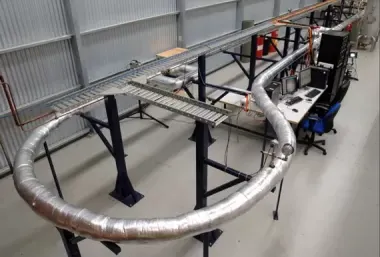
Article
How US energy policy is preventing LNG progress
Significant end-user savings
The potential end-user savings using Virtuoso Hydrate (ViHy) is greater than US$500M in CAPEX and US$50M per year in OPEX, per development.
Featured fact:
The ViHy model, an application of Wood’s Virtuoso software, is the world’s first industry-grade design and operational digital twin tool for hydrate risk quantification in gas dominant systems and consequent design and/or production operations optimization.
Within the upstream oil and gas industry, hydrates have the potential to cause severe blockages in multiphase production systems, leading to the loss of production and revenue. Accounting for the necessary remediation activities, a single blockage event can cost millions of dollars.
In the face of such risk, operators have tended towards extremely conservative philosophies and procedures, such as overdosing and wholesale production shutdown when MonoEthylene Glycol (MEG) supply is disrupted, even when there is little or no chance that a hydrate nucleation would occur. Such strategies are forced by the absence of accurate, real-time, operational knowledge of hydrate thermodynamics and mechanics in the pipeline.
Application of real-time, multiphase simulation to production operations is a particular area of expertise for Wood. Wood’s Virtuoso is a suite of software tools for robust, real-time management of oil and gas, CO2 and hydrogen pipeline and process systems. The highly flexible software provides many operational and commercial functionalities to help address the most complex gathering, production, transportation and processing issues, customized to the unique challenges of our clients’ installations.
Operators use Virtuoso for both online and offline management of complex production and sequestration systems as well as training, what-if analysis, reliability and flow assurance. Virtuoso provides vital monitoring and advisory functions, ensures operational integrity, enables production operations management and optimization, provides performance assessment and facilitates planning, forecasting and data analysis.
To tackle the problem of hydrates, Wood partnered with the University of Western Australia (UWA), to combine Virtuoso with UWA’s hydrate kinetics model for gas-dominant systems. The resulting ViHy model is the world’s first industry-grade design and operational digital twin tool for production operations that can quantitatively predict the hydrate formation and blockage risk.

Hundreds of millions of dollars are invested annually in facilities across the world to prevent hydrates from forming during production. Remediating hydrate blockages from upstream production systems is normally an expensive and time-consuming exercise. Therefore, normal hydrate management strategies revolve around completely avoiding hydrate formation, based on extremely conservative considerations.
In gas condensate systems, this often means that expensive chemicals, such as MEG, Low Dosage Hydrate Inhibitors (LDHI) or Methanol are dosed into production fluids to prevent hydrates from forming, and the availability of these inhibitors is often considered production critical.
Currently, the risk factors of hydrate formation cannot be quantitatively analyzed by industry-grade software packages, neither during design studies nor during operations. For the first time, the ViHy model allows engineers to make decisions based on quantitative assessments of the true risk posed by hydrates. This represents an enormous opportunity for the gas condensate production industry, with potential end-user savings greater than US$500M in CAPEX and US$50M per year in OPEX, per development.
Additionally, a hydrate risk assessment study was recently conducted using ViHy model for a large gas production network in the Middle East, which helped the operator realize a potential savings of approximately US$125M over the life of field.
Wood’s Virtuoso Hydrate Blockage Prediction Model was named a finalist in the 2023 Gulf Energy Information Excellence Awards for Best Modeling Technology. This award recognizes the best use of modeling or simulation software to optimize plant design or engineering for increased safety, efficiency and profitability. The Gulf Energy Excellence Awards program unites upstream, midstream and downstream industry leaders to celebrate innovative, forward thinkers bringing cutting-edge technological advancements to the energy sector.



Pictured from left to right in banner image: Azad Hessamodini, Executive President of Consulting at Wood; Eric May, CEO of the Future Energy Exports Cooperative Research Centre and Professor at UWA; Miranda Taylor, CEO of the National Energy Resources Australia (NERA); James Holbeach, Global Director of Production Optimization at Wood; Zachary Aman, Professor at UWA and Chair of the Board of Studies in Mathematical and Physical Sciences at the UWA School of Engineering
Click the button below, and one of our consultants will get back to you shortly.